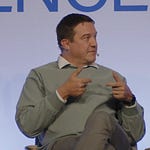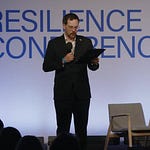Space is no longer sleepy. It is busy, crowded, and contested. In this Resilience interview, we spoke with Neil Buchanan of Lodestar, a company that says it is building an AI “fighter pilot” for satellites. It is not a laser show. It is a brain that rides along with a satellite, sees a threat, predicts the next move, and acts.
The pitch is simple. High-value satellites keep our lives stitched together. If someone sidles up to one of those assets, you want a guardian that can watch, record, and respond. Lodestar calls them bodyguard satellites. The goal is one to one at first, then fleets that can manage multiple targets.
“It’s like a Ring doorbell for space,” said co-founder Neil Buchanan.
Buchanan started by studying hypervelocity impacts. Grains traveling at seven kilometers per second carry absurd energy. During his research, he worked on armor for satellites and on systems to keep collisions from happening. Lodestar is the next step.
Lodestar has its first payload heading up early next year. The early mission is data. How do objects look to an on-orbit sensor when you are near them, not thousands of kilometers away. Classic satellites were never built to see each other, said Buchanan. “They were meant to be left alone for decades.”
That world is gone.
I raised the risk that counter-moves could spiral. He did not blink.
“That’s the whole point we’re trying to avoid in the first place.” The fight he sees is “the gray zone,” where actors “stalk” and “jam,” sowing doubt in an operator’s mind. Lodestar’s first move is modest by design. By simply watching potential enemy satellites, they can begin to learn to defend against attackers.
“That now unlocks a new level of deterrence that so far we just don’t have,” he said. “We’re really focused on being able to prevent these actions from happening in the first place.”
Lodestar is seeing serious investment enter the field, even if the idea sounds futuristic.
“We’re seeing the winds really change here in Europe,” he said. “Germany is putting 30, 35 billion towards this by the end of 2030.”
The center of gravity is American for now.
“That’s where we have the most success,” he said, citing talent, risk appetite, and buyers. He called this “a generational N of one company,” the kind of pitch that gets real investors off the fence.
On competition, he cut to the core. The asset is not the satellite, it is the AI.
“The hill we want to live on here is around the way that our model interprets the data it sees,” he said. “We want reconstruction of the asset at a distance, classification of what you see.”
The threat is not tomorrow. It is here.
“We saw that about five to ten years ago,” he said when I asked about GPS jamming from space. He cited public remarks in the UK that Russian satellites routinely fly close in GEO and jam. The first move in the Ukraine war hit a commercial constellation.
“We have already had the first space war,” he said. “It’s the next one now that we’re worried about and trying to prevent.”
Timelines are short.
“We have our first satellite going up to orbit at the beginning of next year.” The early job is to learn what proximity really looks like, then expand with partners. They refuse long bets on fixed hardware.
“There’s no point starting a five-year R&D program to then find out in five years that the problem’s moved on,” he said.
I asked Buchanan if they had any notable battles in space so far. He demurred.
“If what we’re building works, no one will ever have to know about it,” he said.










